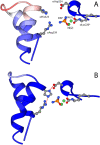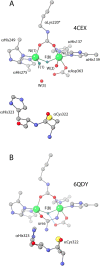The structure-based reaction mechanism of urease, a nickel dependent enzyme: tale of a long debate
- PMID: 32809087
- PMCID: PMC7433671
- DOI: 10.1007/s00775-020-01808-w
The structure-based reaction mechanism of urease, a nickel dependent enzyme: tale of a long debate
Erratum in
-
Correction to: The structure-based reaction mechanism of urease, a nickel dependent enzyme: tale of a long debate.J Biol Inorg Chem. 2021 Feb;26(1):171-173. doi: 10.1007/s00775-021-01855-x. J Biol Inorg Chem. 2021. PMID: 33591411 Free PMC article. No abstract available.
Abstract
This review is an attempt to retrace the chronicle that starts from the discovery of the role of nickel as the essential metal ion in urease for the enzymatic catalysis of urea, a key step in the biogeochemical cycle of nitrogen on Earth, to the most recent progress in understanding the chemistry of this historical enzyme. Data and facts are presented through the magnifying lenses of the authors, using their best judgment to filter and elaborate on the many facets of the research carried out on this metalloenzyme over the years. The tale is divided in chapters that discuss and describe the results obtained in the subsequent leaps in the knowledge that led from the discovery of a biological role for Ni to the most recent advancements in the comprehension of the relationship between the structure and function of urease. This review is intended not only to focus on the bioinorganic chemistry of this beautiful metal-based catalysis, but also, and maybe primarily, to evoke inspiration and motivation to further explore the realm of bio-based coordination chemistry.
Keywords: Catalytic mechanism; Crystal structure; Helicobacter pylori; Klebsiella aerogenes; Nickel; Sporosarcina pasteurii; Urease.
Conflict of interest statement
The authors declare no conflict of interest.
Figures











Similar articles
-
Chemistry of Ni2+ in urease: sensing, trafficking, and catalysis.Acc Chem Res. 2011 Jul 19;44(7):520-30. doi: 10.1021/ar200041k. Epub 2011 May 4. Acc Chem Res. 2011. PMID: 21542631
-
The Structure of the Elusive Urease-Urea Complex Unveils the Mechanism of a Paradigmatic Nickel-Dependent Enzyme.Angew Chem Int Ed Engl. 2019 May 27;58(22):7415-7419. doi: 10.1002/anie.201903565. Epub 2019 Apr 30. Angew Chem Int Ed Engl. 2019. PMID: 30969470
-
Selectivity of Ni(II) and Zn(II) binding to Sporosarcina pasteurii UreE, a metallochaperone in the urease assembly: a calorimetric and crystallographic study.J Biol Inorg Chem. 2013 Dec;18(8):1005-17. doi: 10.1007/s00775-013-1049-6. Epub 2013 Oct 15. J Biol Inorg Chem. 2013. PMID: 24126709
-
Nickel trafficking system responsible for urease maturation in Helicobacter pylori.World J Gastroenterol. 2013 Dec 7;19(45):8211-8. doi: 10.3748/wjg.v19.i45.8211. World J Gastroenterol. 2013. PMID: 24363511 Free PMC article. Review.
-
Lead Molecules for Targeted Urease Inhibition: An Updated Review from 2010 -2018.Curr Protein Pept Sci. 2019;20(12):1158-1188. doi: 10.2174/1389203720666190320170215. Curr Protein Pept Sci. 2019. PMID: 30894105 Review.
Cited by
-
Physical properties and pharmacological applications of Co3O4, CuO, NiO and ZnO nanoparticles.World J Microbiol Biotechnol. 2023 Jun 3;39(8):220. doi: 10.1007/s11274-023-03657-6. World J Microbiol Biotechnol. 2023. PMID: 37269437
-
Leveraging core enzyme structures for microbiota targeted functional regulation: Urease as an example.Imeta. 2025 Apr 16;4(3):e70032. doi: 10.1002/imt2.70032. eCollection 2025 Jun. Imeta. 2025. PMID: 40469508 Free PMC article.
-
Developing a fluorometric urease activity microplate assay suitable for automated microbioreactor experiments.Front Bioeng Biotechnol. 2022 Sep 14;10:936759. doi: 10.3389/fbioe.2022.936759. eCollection 2022. Front Bioeng Biotechnol. 2022. PMID: 36185447 Free PMC article.
-
Optimized Ebselen-Based Inhibitors of Bacterial Ureases with Nontypical Mode of Action.J Med Chem. 2023 Feb 9;66(3):2054-2063. doi: 10.1021/acs.jmedchem.2c01799. Epub 2023 Jan 20. J Med Chem. 2023. PMID: 36661843 Free PMC article.
-
Anti-urease therapy: a targeted approach to mitigating antibiotic resistance in Helicobacter pylori while preserving the gut microflora.Gut Pathog. 2025 May 28;17(1):37. doi: 10.1186/s13099-025-00708-1. Gut Pathog. 2025. PMID: 40437630 Free PMC article. Review.
References
-
- Blakeley RL, Hinds JA, Kunze HE, Webb EC, Zerner B. Jack bean urease (EC 3.5.1.5). Demonstration of a carbamoyl-transfer reaction and inhibition by hydroxamic acids. Biochemistry. 1969;8(5):1991–2000. - PubMed
-
- Dixon NE, Riddles PW, Gazzola C, Blakeley RL, Zerner B. Jack bean urease (EC 3.5.1.5). V. On the mechanism of action of urease on urea, formamide, acetamide, N-methylurea, and related compounds. Can J Biochem. 1980;58(12):1335–1344. - PubMed
Publication types
MeSH terms
Substances
Supplementary concepts
LinkOut - more resources
Full Text Sources
Other Literature Sources

